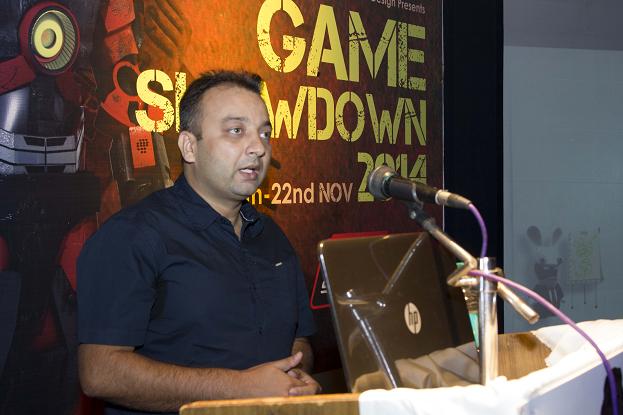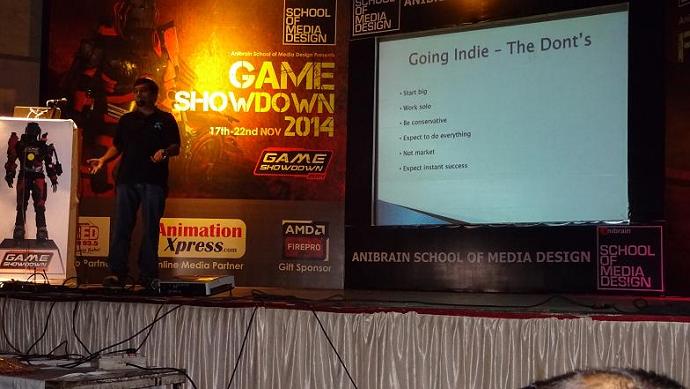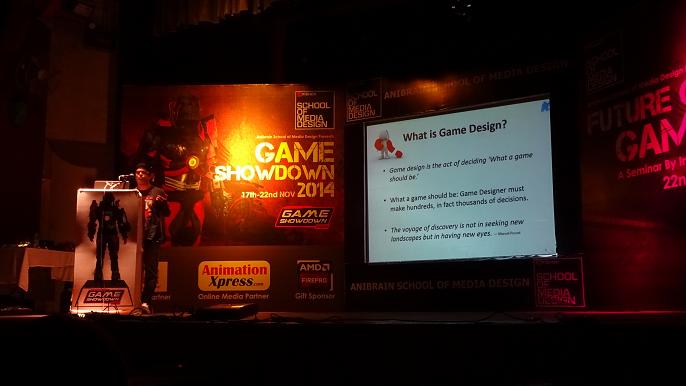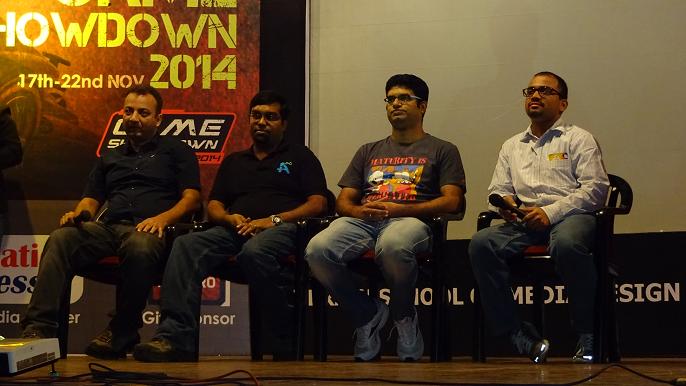Anibrain School of Media Design’s The Game Showdown 2014 ended on 22 November, with a great line-up of eminent speakers from the industry coming down to the venue to encourage kids and professionals alike and give them the correct guidance and insights as to how to enter the industry.
The event started with a video about how the video games have evolved over the years and how the advanced technology has enabled us to make the video games that are almost life-like in today’s day and age.
Syed Abbas, Head of Production at Ubisoft’s Pune Studio – having over a decade of experience in game production and currently heading the studio – started off the proceedings with a lot of impetus on the future’s game developers and artists. Ubisoft Pune boasts of being one of the first studios in India to produce PS3 games, will be the first one to produce PS4 games as well.

Syed informed the audience about the $83 billion video game industry and how it is fast catching up in the country. Being on the production side, he stressed on the future of the game production and how new technologies like gaming through set-top boxes may be the next thing for the industry to stake claim on. “Tracking the player all the time and to see what the playing trend is and how you could get the game to be more engaging,” he added. “Game development does not limit to game production and a lot of production continues after the game with the release of additional content after launch in the form of DLCs. The additional content in the game is necessary for the gamers to continue being engaged with the game and the DLCs provides that extra bit of playing time for their favourite games.”
He stressed on optimizing the game throughout the game cycle, while adding that the agile game development method was the future of game development. ‘Agile game development’ method is a set of collected experiences of what works and what doesn’t work with iterative approaches and practices as applied to over a decade of game development with all genres and platforms. He further encouraged the future developers to keep playing across genres, reviewing, and working on the newer ideas. “Newer production profiles are opening up with the production cycles being long and tedious. The talent demand and supply gap is much wider in the gaming industry which needs to filled and game jams like this are bringing much relief to the industry in providing the necessary talent,” he ended.

Venkat Chandar, Co-founder and Indie Developer at Axiom Studios, was one of the speakers who had come to the Showdown to talk about the Indie scene in the country. With rise of the mobile phone industry and smartphones taking the Indian market by storm, casual gaming is one of the biggest game markets the Indie developers could start with. “When starting your own game be your biggest critic. Be your game’s marketing guy and spread the word across all the forums and communities and ask other indie developers to try the game and give feedback. Maintain a developer’s diary and keep an update on the daily development you do while the game is in the development. Be able to fund your own game and be independent in the aspect that you make a game that you want to play,” Venkat added.
He further mentioned a few shocking facts about the Indian gaming market where he mentioned only 2 out of 100 people in the country are serious gamers who devote certain amount of hours on playing games. He stated about lot of opportunities in the tier 2 and tier 3 cities which are still an untouched market in terms of the game players one could get.
Vivek Dani, Founder at Rhippo Studio addressed the crowd about game design and what is it like to spend a day as a game designer.

“As a game designer one should have basic knowledge of visual arts, animations, architecture, business, cinematography, communication, economics, engineering, mathematics, music, psychology and many more which the help the designers project a game for the audience,” he said.
He further added: “A game designer is a bridge between every department in the studio and also between the studio and the audience. He has to convey what the game is to the audience and how exactly should they feel while playing the game. The gamers should be attracted to the story and then to everything else. They should have empathy towards the game as this creates a repeat value for the game.”
Rajiv Indimath, Advisor at Catapooolt.com, a crowd funding website spoke about how crowd funding can enable the gaming industry and various challenges in the production could be overcome with the use of crowd funding instead of going for different revenue streams.
He shared a few figures which showed developing countries like India having a tremendous growth in the crowdfunding market. With over 200 gaming studios coming up in the last five years, gaming in India is certainly one of the emerging verticals within the M&E industry. He also mentioned that of these 200 studios, the Indies certainly found it very tough to fund their games and with focus on monetisation, developers tend to sometimes forget about the core, which is the game design.
To tackle all of these problems, Catapooolt is planning to start crowd funding exclusively for the game developers and see to it that these games come out in the market and provide a launchpad for a lot of these game studios.

Four of them together had a very similar take on how should one progress if one has to make deep inroads in the industry. One has to play a lot of games and know the current trends in the industry. Take ideas but not blatantly copy or try to imitate a game. Be original and put in a lot of crazy ideas before settling for one. And lastly, if your product does not have the quality, then no matter how well you market your game, it is not going to go the distance. Quality is the first guaranteed step towards success of a game. On this note the conference ended with the prize distribution taking place where the winners in the three categories were: Cool Dude Studios in the school category; Sceptre in the college category and Axiom Studios in the professional.
Anibrain School of Media Design’s The Game Showdown was one of the first of its kind online gaming competition and received tremendous response with a number of entries in the first year of the competition itself. Competitions like these create a lot of awareness about the gaming scene and how to develop games. Also, eminent industry professionals coming in support of such initiatives will help the kids identify their correct talent.
